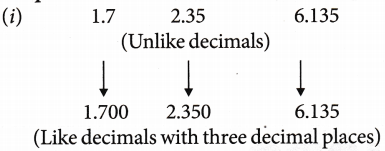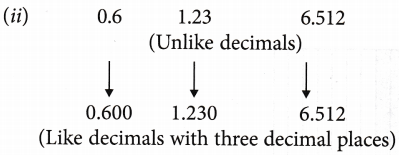How do you Convert Unlike Decimals into Like Decimals
Like decimals:
Decimals with the same number of decimal places are called like decimals.
Examples: 0.6, 3.5, 6.1 ( one decimal place)
2.15,0.78,26.11 (two decimal places)
Unlike decimals:
Decimals having different number of decimal places are called unlike decimals.
Examples: 0.7, 2.12, 6J25 are unlike decimals 3.12, 0.8, 13.856 are unlike decimals
Converting Unlike Decimals into Like Decimals
We can convert unlike decimals into like decimals by adding zeros to the right of decimal point or by finding their equivalent decimal.
Note:
Unlike decimals can also be equivalent decimals. Examples: 0.3, 0.30, 0.3000 are unlike but equivalent decimals.
Examples:


Comparing Decimals
To compare the decimals, we have to follow the following steps:
- Convert unlike decimals into like decimals.
- Compare the whole number part. The decimals with greater whole number part is greater.
- If the whole number part is equal, then compare the digits in the tenth place. The decimal with greater digit in the tenth place is greater.
- If digits in the tenth place are also equal, then compare the digits in the hundredth place and so on.
Example: Which decimal is greater, 78.40 or 78.216?
Solution:
Converting the given decimals into like decimals
78.40 = 78.400
78.216 = 78.216

∴ 78.400 >78.216
so, 78.40 >78.216
Read More About:
- What is the meaning of Place Value and Face Value in Maths?
- What is the Place Value Chart of an Indian and International System?
- What is a Decimal Value and Place Value of Decimals?
- How do you Round to the Nearest Ten Thousand
- What is the Definition of an Equivalent Decimal
- Converting To and From Scientific Notation
- What is the Difference between Ascending and Descending Order
- Addition and Subtraction of Decimals
- How do you Multiply and Divide Decimals?
- How do you Convert Fractions into Decimals and Vice Versa
